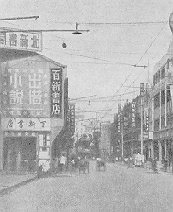 |
 |
 |
|
| |
|
|
 Book
Market Book
Market |
|
 |
Shanghai
was once the center of the book industry in China. Statistics
show that there were over 500 bookshops of various sizes
in the city in 1948, not including the news-stands, of
which there were over a thousand. Nearly all the influential
bookshops in China were concentrated in Fuzhou Road and
thereabouts. Like Liuli Chang in Beijing, Fuzhou Road
also enjoyed the reputation of being a "Culture Street".
But in the early period, Fuzhou Road was once the red-light
district of the city, where brothels existed by the dozen,
and which earned for it the ironical name of "Decency
Street".
|
 "Culture
Street" of former days
"Culture
Street" of former days |
 Wangping
Street (now Shandong Road), where newspaper sellers
obtained their daily wares
Wangping
Street (now Shandong Road), where newspaper sellers
obtained their daily wares |
The
name "Culture Street", however, refers only
to the middle section of Fuzhou Road, an area not exceeding
500 square meters, bordered by Henan Road in the east,
Fujian Road in the west, Hankou Road in the north and
Guangdong Road in the south. Within its confines were
more than a hundred bookshops and newspaper offices, the
sheer number of which turned the place into a kind of
market which was accordingly dubbed "Shanghai's Book
Market".
|
| In
the half century before 1949, "Culture Street"
underwent innumerable changes, but its status as the country's
prime book market never declined. A stroll along "Culture
Street" starting from its east end would have brought
the visitor in no time opposite two four-storeyed buildings
that used to house the well-known giants of the book industry:
the Commercial Press and the Zhonghua Bookstore. When
he commercial press was first launched in 1897, it operated
with only two printing presses. But it soon turned into
a going concern. It built the building in 1912, and set
up its head office in Baoshan Road, in which were situated
its editing and translation departments, printing house,
school and the Eastern Library. With a staff of over three
thousand, the firm had no equal in the country. In 1931,
the head office of the Commercial Press was destroyed
in a bombing raid by the Japanese. The Zhonghua Bookstore
was founded and opened to business in 1912. By way of
competition, it also erected a four-storeyed building
north of the Commercial Press building. These two bookshops
were well-staffed with scholars and distinguished experts
as editors, who made outstanding contributions to the
editing and publication of books, periodicals, book series,
dictionaries and text-books, and to the translation of
world-famous works. Other old books congregated on Hennan
Road. Bookshops such as Huiwen Tang had as its chief business
the publishing of legal works and ancient fiction. There
were of course the Hukaiwan and Zhonhuchen Brush and Ink
Shops which dealt in Chinese writing paper, brushes, ink
and ink-stones, as well as Rong Baozhai, which sold stone
rubbings, calligraphic scrolls and model, paintings, seals
and red-ink paste. Among the bookshops that lined Fuzhou
Road were: the Kaiming Bookshop, which edited and published
works and books for children and young people, the Beixin
Book shop, which had moved here from Beijing and published
some of Lu Xun's works; the Shanghai Magazine Company
and the China Book and Magazine Company, which opened
in 1921, did a brisk business in editing and publishing
primers and English text-books, thus forming a sort of
tri-partite consortium together with the Commercial Press
and Zhonghua Bookstore. The Shenghua and Xinzi Bookshops
and the Readers Publishing House were newcomers, but they
were extraordinary nevertheless for the influence they
exerted on the youth. Among the books they published were
"Das Kapital", "Anti-Duhring", "
On Imperialism" and other Marxist and Leninist classics.
Apart from bookshops, more than ten newspaper firms ad
their offices in Shandong Road (Central) which was also
known as " Newspaper Street" and ran across
the northern section of Fuzhou Road. Every day at dawn
and around two o'clock in the afternoon, the place swarmed
with newspaper sellers, both man and boys, waiting to
pick up their wares. |
In
1937, many bookshops in Shanghai moved inland on account
of the war, which left "Culture Street" a dreary
and desolate place, but it revived and prospered when
the bookshops came back in 1945. With liberation in 1949,
the state-owned Xinhua Bookstore was founded and branched
out to all parts of the city. New changes took place in
the book market, and " Culture Street" became
virtually extinct. The bookshops of former days have been
re-organized according to their specialty into science
and technology, foreign languages, classics, second-hand
and other kinds of bookshops. The former site of the Commercial
Press and the Zhonghua Bookstore have become what is today
the biggest Science and Technology Bookstore in Shanghai.
|
 Book counters
at the Shanghai Science and Technology Bookstore
Book counters
at the Shanghai Science and Technology Bookstore
|
The
bookshops in Shanghai are playing a significant role
in the modernization of our country.
|
|
|
|
|
 |
 |
 |
|
|
|
|
|
|
|


